Cochliobolus heterostrophus (southern leaf spot)
Identity
- Preferred Scientific Name
- Cochliobolus heterostrophus (Drechsler) Drechsler
- Preferred Common Name
- southern leaf spot
- Other Scientific Names
- Bipolaris maydis (Y. Nisik. & C. Miyake) Shoem
- Drechslera maydis (Nisikado & Miyabe) Subram. & Jain, 1966
- Helminthosporium maydis Y. Nisik.
- Ophiobolus heterostrophus Drechsler
- International Common Names
- Englishmaydis leaf blightsouthern corn leaf blightsouthern leaf blight of maize
- Spanishmancha de la hoja del maiz
- Frenchhelminthosporiose du maïs
- Local Common Names
- GermanyBlattfleckenkrankheit: Mais
- EPPO code
- COCHHE (Cochliobolus heterostrophus)
Pictures
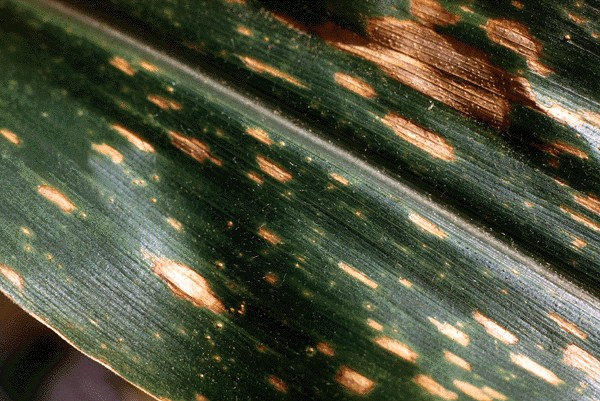
Infected maize leaf
Leaf spots on maize leaf caused by C. heterostrophus.
Mauritius Sugar Industry Research Institute

Symptoms on maize leaf
©J.M. Waller/CABI BioScience
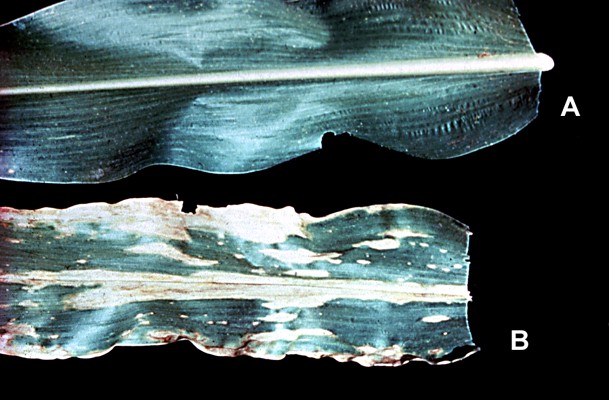
Symptoms on maize leaf
Effect of Texas cytoplasm on susceptibility to Race T.
©J.M. Waller/CABI BioScience
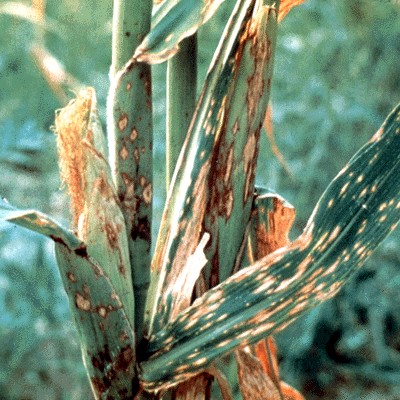
Symptoms on maize plant
Race T symptoms on leaf, stem, and sheath.
©CIMMYT
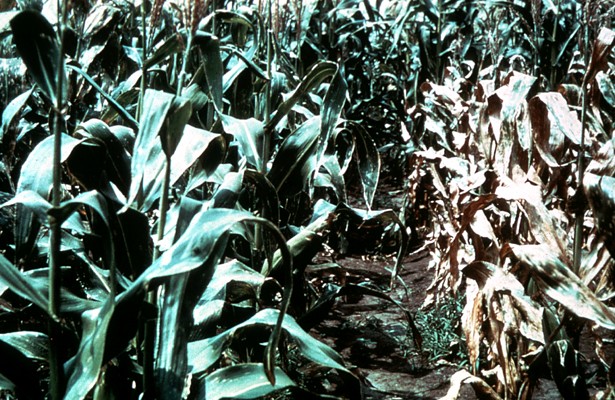
Symptoms on maize crop
Effect of Texas cytoplasm (right) on susceptibility to Race T.
©J.M. Waller/CABI BioScience
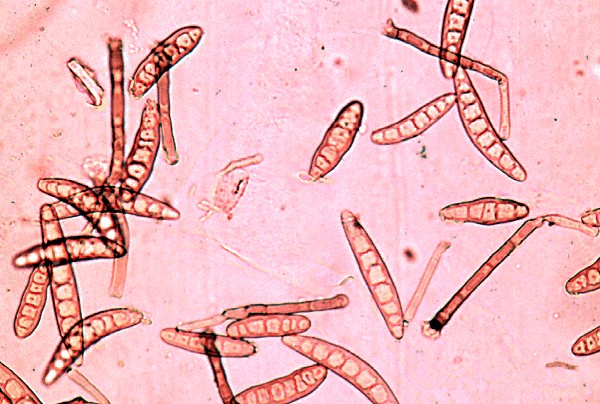
Conidia
Conidia of C. heterostrophus (magnification x400); conidia measure 70-160 x 15-20 µm.
Mauritius Sugar Industry Research Institute

Conidia
©J.M. Waller/CABI BioScience
Distribution
Host Plants and Other Plants Affected
| Host | Host status | References |
|---|---|---|
| Arachis hypogaea (groundnut) | Other | |
| Glycine max (soyabean) | Other | |
| Helianthus annuus (sunflower) | Other | |
| Microstegium vimineum (Nepalese browntop) | Wild host | Huang et al. (2017) |
| Oryza sativa (rice) | Other | |
| Pennisetum glaucum (pearl millet) | Other | |
| Pisum (pea) | Other | |
| Populus deltoides (poplar) | Other | |
| Rottboellia cochinchinensis (itch grass) | Other | Macedo et al. (2016) |
| Sorghum bicolor (sorghum) | Other | |
| Sorghum sudanense (Sudan grass) | Wild host | |
| Triticum (wheat) | Other | |
| Vigna unguiculata (cowpea) | Other | |
| Zea mays (maize) | Main | Hulagappa et al. (2013) Dai et al. (2016) Muradov et al. (2019) |
| Zea mays subsp. mays (sweetcorn) | Main | |
| Zea mays subsp. mexicana (teosinte) | Other |
Symptoms
Lesions on maize leaves, caused by race O, are elongated between the veins, tan in colour, 2-6 x 3-22 mm long, with limited parallel margins and buff-to-brown borders. Variation in lesion size and shape may occur between inbreds and hybrids with different genetic backgrounds. Race O usually attacks only the leaves.Lesions produced by race T are tan in colour, 0.6-1.2 x 0.6-2.7 cm, spindle-shaped or elliptical, with yellow-green or chlorotic halos. Later, race T lesions often have dark, reddish-brown borders and may occur on the leaves, stalks, leaf sheaths, ear husks, shanks, ears and cobs. A black, felty mould may cover affected kernels, and ear and cob rot may occur, with substantial losses in harvesting and shelling.Seedlings from kernels infected by Race T may wilt and die within 3 to 4 weeks after planting. The early death of leaves, resulting from infection by either race, predisposes the plants to stalk rot (Boothroyd, 1971).
List of Symptoms/Signs
| Symptom or sign | Life stages | Sign or diagnosis |
|---|---|---|
| Plants/Inflorescence/lesions on glumes | ||
| Plants/Leaves/abnormal colours | ||
| Plants/Leaves/fungal growth | ||
| Plants/Leaves/wilting | ||
| Plants/Seeds/discolorations | ||
| Plants/Seeds/rot | ||
| Plants/Stems/discoloration of bark |
Prevention and Control
Cultural Control and Sanitary Methods
Destroying or burying crop residues can be a beneficial practice. Lower levels of disease developed in ploughed plots than in tillage systems in which more crop residues were left on the surface (Sumner and Littrell, 1974). The germination of spores exposed on the soil surface was significantly greater than the germination of buried spores (Kingsland, 1972). Continuous maize culture increased the severity of the disease (Bekele and Sumner, 1983).
Host-Plant Resistance
Race T, the cause of the 1970 epidemic of southern corn leaf blight, only attacks maize with Texas male-sterile cytoplasm (T-cms). The pathogenicity of race T is expressed by the action of T-toxin produced by the fungus. The toxin has been associated with disruption of the mitochondrial function in susceptible plants (Holden and Sze, 1989). The mitochondrial gene, T-urf13, from T-cms maize, is responsible for sensitivity to T toxin produced by the pathogen (Braun et al., 1989). The molecular basis of disease susceptibility in the T-cms maize is currently under investigation (Levings and Siedow, 1992). Race O attacks a broad range of genotypes. The recessive gene, rhm, confers chlorotic-lesion resistance to C. heterostrophus race O, in otherwise susceptible maize plants (Zaitlin et al., 1993). Ultrastructural observations on 1-4-day-old seedlings of an inbred line of male-fertile maize inoculated with race O conidia revealed that, although mesophyll cells degenerated at an early stage, bundle sheath and phloem cells remained intact even in 4-day-old lesions (Smith and Toth, 1982).Molecular studies of resistance indicate that the rhm gene is tightly linked to two RFLP marker loci (UMC85 and p144) that map to the short arm of chromosome 6. Polymerase chain reaction assays confirmed the linkage between rhm and the p144 RFLP marker locus in a second unrelated F2 population (Zaitlin et al., 1993). Tagging the rhm gene with transposable elements suggested that there are two linked recessive genes controlling resistance (Chang and Peterson, 1995).Field and laboratory experiments in China showed that the subgroup CI (CMS-C) of group C maize was particularly susceptible to C. heterostrophus race C, but subgroups CII (CMS-RB) and CIII (CMS-ES) were not seriously infected (Liu et al., 1991).Various screening methods for resistance have been investigated, including detached leaf techniques (Lakshmi and Sharma, 1987), tissue culture (Kuehnle and Earle, 1988) and seedling assays (Tajimi et al., 1985). Conventional pedigree or recurrent selection methods continue to be effective in breeding for improved resistance to southern leaf blight (Shieh and Lu, 1993).
Chemical Control
Foliar applied fungicides that effectively control C. heterostrophus include dinocap and carbendazim (Saxena et al., 1985), mancozeb (Schenck and Stelter, 1974), maneb, dithane, propiconazole and chlorothalonil (Burnette and White, 1985; Comstock et al., 1974).
Biological Control
No biological control methods or products exist for C. heterostrophus; however, potential biological control agents have been identified. Antifungal agents include the substance Ac-1 produced by a Streptomyces sp. (Matsuyama, 1991); the bacterium Pseudomonas cepacia (Upadhyay and Jayaswal, 1992); and the fungus Trichosporon sp. (Wang and Wu, 1987). Some saprophytic fungi occurring on the phylloplane of maize show antagonistic activity in vitro against C. heterotrophus (Mangiarotti, 1987). Microorganisms which were antagonistic to C. heterostrophus in culture were isolated from conidia and lesions on maize leaves (Sleesman and Leben, 1976). Natural products that show some fungicidal activity against the fungus include an extract of Portulaca oleracea (Noriel and Robles, 1990) and 1,3,7-trimethylxanthine, isolated from coffee (Rizvi et al., 1980).
Impact
Southern corn leaf blight reached epidemic proportions in the USA in 1970, resulting in losses estimated at one billion dollars (Ullstrup, 1972). The epidemic was caused by race T attacking maize with Texas male sterile cytoplasm (T-cms), which comprised 85% of maize acreage at that time (Ullstrup, 1972). Race O occurs mainly in subtropical and tropical areas, where it causes minor losses. However, up to 50% yield reductions were detected, when race O was inoculated onto susceptible lines (Fisher et al., 1976, Gregory et al., 1978).
Information & Authors
Information
Published In
Copyright
Copyright © CABI. CABI is a registered EU trademark. This article is published under a Attribution-NonCommercial-NoDerivatives 4.0 International (CC BY-NC-ND 4.0)
History
Published online: 25 February 2023
Language
English
Authors
Metrics & Citations
Metrics
SCITE_
Citations
Export citation
Select the format you want to export the citations of this publication.
EXPORT CITATIONSExport Citation
View Options
View options
Get Access
Login Options
Check if you access through your login credentials or your institution to get full access on this article.


